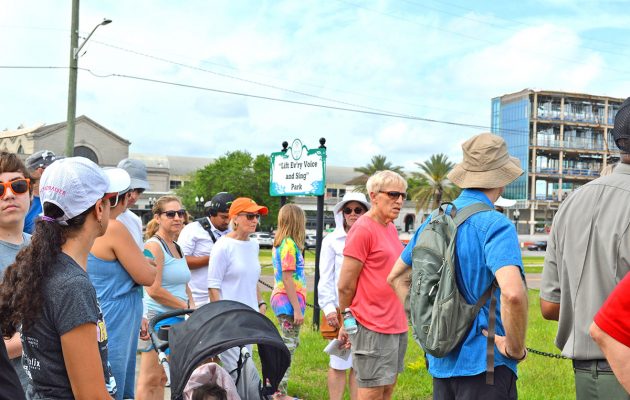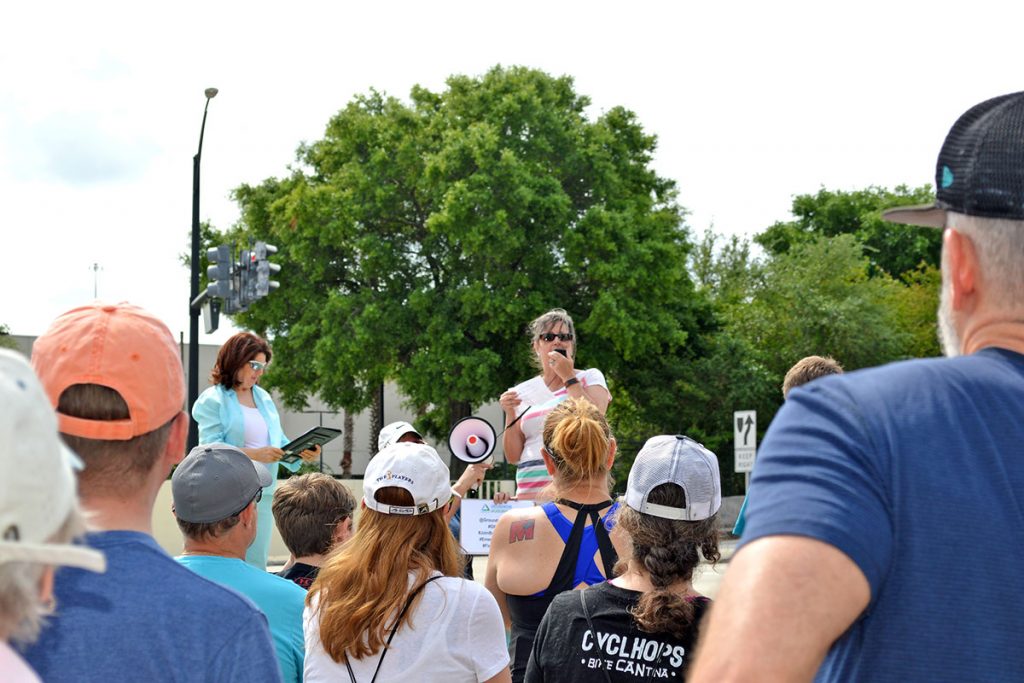Emerald Trail first mile walk brings completion one step closer

It has been more than a century since architect Henry Klutho came up with the gem of an idea to build a circle of trails connecting the neighborhoods around downtown Jacksonville, and his plan is finally coming close to fruition.
At the Emerald Trail first mile walk, held April 13, hundreds came out to walk the site where the beginning of the trail will be built. Maps were distributed and docents led small groups along the route, stopping at several points of interest along the way to explain how the Emerald Trail will be built and what it will look like when finished.
The walk began at the Prime Osborn Convention Center and concluded at the south end of the existing S-Line Rail. Plans for the first mile of the trail include making the Park Street viaduct more pedestrian- and bicycle-friendly by adding a dedicated two-way bicycle track and a pedestrian area with benches and art; a proposed greenway along East Duval Street with an overlook area adjacent to the pond, and the proposed side path on Church Street could possibly use the FDOT land under I-95 to transition into a greenway heading through city-owned greenspace.
Groundwork Jacksonville’s Emerald Trail Master Plan was approved by the City Council March 26. The $88,200 plan cost was privately underwritten by a $50,000 donation from JTC Running (JTC) and through grants from Local Initiatives Support Corporation (LISC) and the Giving Forward Community Endowment Fund at The Community Foundation for Northeast Florida.
According to Ehas, the next step will be to design and build the “Model Project,” a portion of the trail that will be highly utilized and will offer the community a tangible example of what the finished Emerald Trail can be. The 1.3-mile Model Project will connect the south end of the existing S-Line Rail Trail to the intersection of Park Street and Stonewall Street, near the convention center. The goal is to have the project completed in 2020.
“The Emerald Trail will not only create unprecedented recreational opportunities in the urban core, it is a transformative transportation and economic redevelopment project,” said Ehas. “Groundwork sees Jacksonville’s neighbor to the north as an example of the impact this project could have. If you look at the Atlanta BeltLine, the direct economic impact is almost $4 billion dollars thus far. We believe the Emerald Trail will deliver significant economic benefits to Jacksonville as well.”

The estimated cost of the Emerald Trail is $31 million, not including land purchases, and it will take approximately 10 years to create and connect 30 miles of new and existing trails in the urban core. Groundwork Jax is responsible for raising half the money for design and permitting costs from private donors, grants and foundations. The trail will eventually connect to 18 public schools, two colleges, and 28 parks directly and within three blocks of another 20 schools and 20 parks.
“Everyone involved in revitalizing Jacksonville is looking for ways to create a more livable, walkable, recreational downtown to attract residents, visitors and business expansion to the urban core,” said District 5 Councilwoman Lori Boyer. “The Emerald Trail will help to accomplish this while also improving mobility and economic opportunity for those who currently live in the historic urban neighborhoods along the proposed trail.”
By Kandace Lankford
Resident Community News






